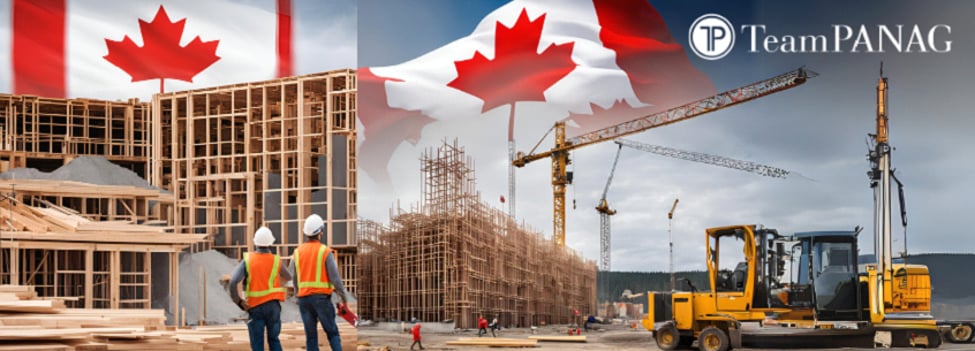Introduction
Tariffs—taxes imposed on imported and exported goods—can have a profound impact on Canada’s housing market. While often discussed in the context of international trade and economic policies, tariffs directly affect home prices, construction costs, and housing supply. In Canada, where affordability and housing shortages are major concerns, tariffs on essential building materials can further exacerbate these issues.
In this blog, we’ll explore how tariffs influence the Canadian housing market, examining their effects on construction costs, home prices, market trends, and foreign investments.
1. Rising Construction Costs Due to Tariffs
One of the most immediate ways tariffs impact the housing market is by increasing the cost of construction materials. Canada relies heavily on imported materials such as steel, aluminum, and lumber. When tariffs are imposed on these goods, builders face higher costs, which are passed on to homebuyers and renters.
Examples of Tariff Impact on Construction Costs
⦁ U.S. Tariffs on Canadian Lumber: The U.S. has frequently imposed tariffs on softwood lumber exported from Canada, leading to price hikes domestically. Since lumber is a key component in home construction, these tariffs drive up the costs of building new houses.
⦁ Tariffs on Steel and Aluminum: Canada imports steel and aluminum for construction. Tariffs on these materials lead to increased costs for essential infrastructure, including condos and commercial buildings.
The Result?
⦁ Higher construction costs discourage new housing developments.
⦁ Home prices increase, making affordability even more challenging.
⦁ Builders may delay or cancel projects due to budget constraints.
2. Tariffs and Housing Affordability
Canada’s housing market is already facing affordability challenges, especially in cities like Toronto and Vancouver. Tariffs contribute to rising home prices, pushing housing further out of reach for many Canadians.
How Tariffs Affect Affordability:
⦁ Increased New Home Prices: When builders pay more for materials, they raise home prices to maintain profitability.
⦁ Higher Costs for Renovations: Homeowners looking to renovate also face higher costs for materials, making it harder to improve or maintain homes.
⦁ Reduced Supply: As developers face cost challenges, fewer homes are built, leading to a supply shortage that further drives up prices.
According to experts, housing prices in Canada have seen spikes partly due to increasing costs in the supply chain—tariffs are a contributing factor to this.
3. Impact on Foreign Investment in Canadian Real Estate
Tariffs can also influence foreign investment in the Canadian housing market. Many investors look at construction costs, property values, and economic stability before investing in real estate. High tariffs create uncertainties that can deter foreign buyers and developers.
Key Effects on Foreign Investors:
⦁ Less Attractive Market: If tariffs make development more expensive, foreign investors may look elsewhere for better returns.
⦁ Higher Rents: With fewer developments, rental prices may increase due to demand exceeding supply.
At the same time, some foreign investors benefit from tariffs. If Canadian housing prices increase due to limited supply, those who already own properties may see their real estate values rise, leading to higher profits upon resale.
4. The Ripple Effect on the Rental Market
As home prices rise due to tariffs, many Canadians turn to renting instead of buying. However, the rental market is also affected:
⦁ Landlords Pass Costs to Renters: Higher construction and maintenance costs lead to increased rental prices.
⦁ Fewer Rental Properties Available: With developers facing financial pressure, fewer rental units are built, causing supply shortages.
⦁ Rental Demand Surges: As homeownership becomes less affordable, more people seek rentals, further driving up prices.
With already high demand in cities like Toronto, Montreal, and Vancouver, any additional pressure on the rental market makes it even harder for Canadians to find affordable housing.
5. Policy Responses and Potential Solutions
The Canadian government has taken some steps to address the housing crisis, but tariffs remain a challenge. Possible solutions include:
⦁ Negotiating Lower Tariffs on Essential Building Materials: Reducing trade barriers on lumber, steel, and aluminum can lower construction costs.
⦁ Providing Incentives for Domestic Production: Encouraging local manufacturing of building materials can reduce dependence on imports.
⦁ Expanding Affordable Housing Programs: Government subsidies and incentives for builders to create affordable housing can help offset tariff-related price increases.
By addressing these issues, Canada can create a more stable and accessible housing market for its residents.
Conclusion
Tariffs play a significant role in shaping the Canadian housing market by increasing construction costs, affecting affordability, and influencing investment trends. While they serve a purpose in protecting domestic industries, they can also lead to unintended consequences, such as rising home prices and reduced housing supply.
For homebuyers, renters, and investors, understanding how tariffs affect real estate is crucial in navigating Canada’s housing market. As policymakers seek solutions, reducing tariff-related pressures could be a key step in improving housing affordability for Canadians.




